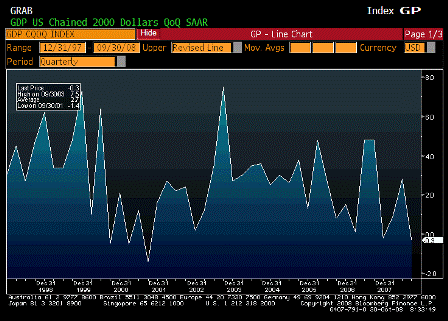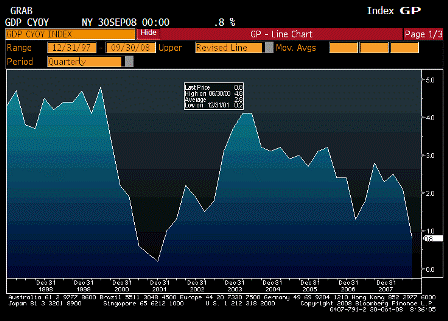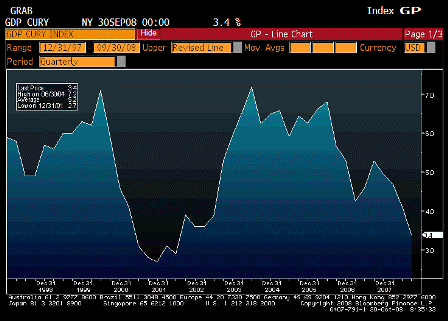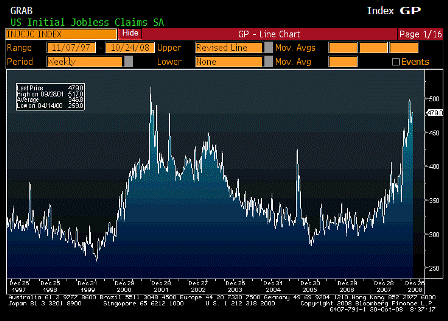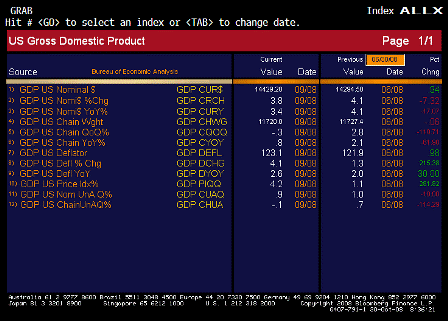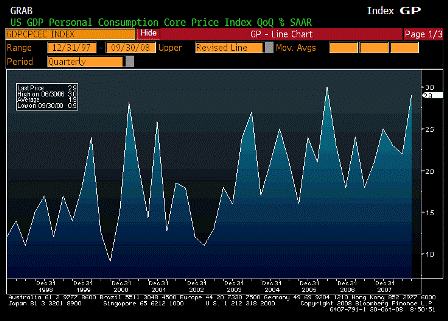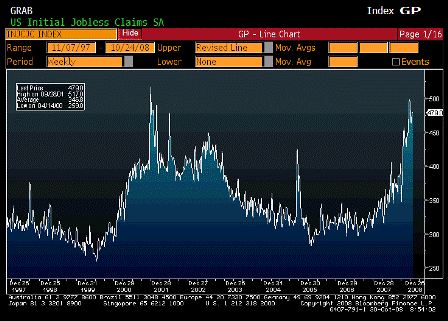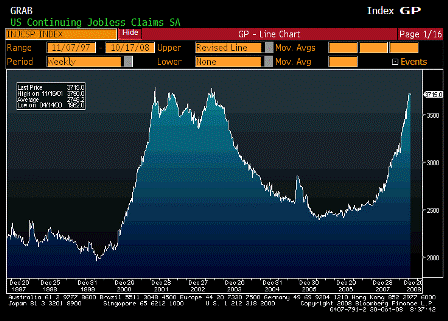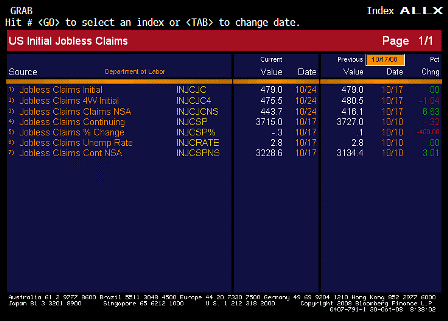(email exchange)
>
> On Wed, Oct 29, 2008 at 11:45 PM, Morris wrote:
>
> This is the 64,000 dollar question…will unlimited FED lending to ENTIRE
> world-with IMF help-created recovery? Push on string? Hyper inflation?
> Question of the day…would love others inputs.
>
I’d say yes, it’s inflationary and the channels at least as follows:
1. The outstanding international dollar debt was an expansionary force when it was growing, to the extent the USD borrowings were spent. Some of that USD spending was overseas, some in the US.
Growing debt, if directed towards spending, is expansionary.
For example, you may borrow to build a house, or buy a new car.
But if you borrow to fund financial assets, your pension fund, or to buy mortgage backed securities, for example, it’s merely the rearranging of financial assets.
This increased ‘leverage’ and has no direct effect on demand, beyond the demand created by the financial institutions themselves. This includes all the hiring of employees for the financial sector which all counts as GDP.
(While this may not be deemed ‘useful output’ it is accounted for as GDP, like bridges to nowhere, and does function to support people’s livelihood. Yes, better to have employed them doing something deemed useful, but that’s another story)
2. Should the USD loans default, the financial institutions lose capital, meaning the shareholders (and bondholders, depending on the size of the loss) lose their nominal wealth. This may or may not reduce spending. Most studies say it’s a weak effect at best.
And for each institution to continue to function it needs to replace capital.
(In our ‘loans create deposits’ world, infinite capital is available at the right price, if the government has a policy to sustain domestic demand.)
For US institutions with USD denominated capital, losses result in a reduction of their USD capital.
Their liabilities remain the same, but their assets fall.
And any assets sold to reduce USD funding needs are sold for USD.
3. Institutions with capital denominated in other currencies, go through the same fundamental process but with another ‘step.’
When their USD assets are impaired, they are left with their USD liabilities.
They now have a ‘mismatch’ as non dollar assets including non dollar capital are supporting the remaining USD liabilities.
To get back to having their assets and liabilities matched in the same currency, they need to sell their assets in exchange for USD.
Until they do that they are ‘short’ USD vs their local currency, as a rising USD would mean they need to sell more of their local currency assets to cover their USD losses.
Technically, when the assets they need to sell to cover USD losses are denominated in non dollar currencies, this involves an FX transaction- selling local currency to buy USD- which puts downward pressure on their currencies.
Additionally, they need to continue to fund their USD financial assets, which can become problematic as the perception of risk increases.
4. The Fed’s swap lines ($522 billion outstanding, last i saw) help the rest of the world to fund themselves in USD.
In an effectively regulated environment, such as the US banking system, this works reasonably well but still carries a considerable risk that we decide to take as a nation for further public purpose. (it is believed the financial sector helps support useful domestic output, etc.)
Any slip up in regulation can result in the likes of the S&L crisis, and arguably the sub prime crisis, which results in a substantial disruption of real output and a substantial transfer of nominal and real wealth.
The Fed is lending to foreign CB’s in unlimited quantities, secured only by foreign currency deposits, to world banking systems it doesn’t regulate, and where regulation is for foreign public purpose.
The US public purpose of this is (best I can determine) to lower a foreign interest rate set in London called ‘LIBPR,’ and ‘perhaps’ to ‘give away’ USD to support US exports.
The Fed yesterday, for example, announced $30 billion of said lending to Mexico and Brazil for them to lend to their banks. The Fed must be a lot more comfortable with Mexico and Brazil’s bank regulation and supervision than I am, and certainly than Congress would be if they had any say in the matter.
5. The problem is that once the Fed provides funding to these foreign Central Banks, who then lend it all to their banking systems, they remove the foreign ‘funding pressure’ that was causing rates to be a couple of % higher over their (didn’t change our fed funds rate). Taking away the pressure takes away the incentives of the pressure to repay $US’s introduces.
The Fed is engaging in a major transfer of wealth from here to there. Initially its prevents the transfer of wealth back to the US, as would have happened if they had been forced to repay and eliminated their USD liabilities and losses.
That same force if continued develops into large increases in USD spending around the world as this ‘free money’ going to banking systems with even less supervision and regulation than ours soon ‘leaks out’ to facilitate increasing foreign consumption at the expense of USD depreciation.
Note the bias- the ECB gets an unlimited line and Mexico is capped at $30 billion.
This means the Fed is making a credit judgment of Mexico vs the ECB, which means the Fed is aware of the credit issue.
Conclusion, the Fed is beginning to recognize the swap lines are potentially explosively inflationary, as evidenced by not giving Mexico unlimited access.
The swap lines are also problematic to shut down should that start to happen, just like what shutting down lending to emerging markets did in the past.
Shutting down the swap lines would trigger the defaults that the unlimited funding had delayed, and then some, triggering a collapse in the world economies.
It’s a similar dynamic to funding state owned enterprises- the nominal costs go up and the losses go up as well should they get shut down.
Keeping them going is inflationary, shutting them down a major disruption to output and employment.
It is delaying the circumstances that were headed toward a shut down of the European payments system, but leaving the risks in place for the day the swap lines are terminated.
7. Bottom line- it looks to me that the swap lines are a continuation of the weak dollar policy Bernanke (student of the last gold standard depression) and Paulson have been pushing for the last couple of years.
This time they are ‘giving away’ dollars to foreigners, in unlimited quantities, ultimately to buy US goods and services.
They are doing this to support export led growth for the US, at the direct expense of our standard of living. (declining real terms of trade)
They are doing this to increase ‘national savings’- a notion applicable under the gold standard of the early 1930’s to prevent gold outflows, and where wealth is defined as gold hoards. This notion is totally non applicable to today’s convertible currency.
It is a failure to understand the indisputable Econ 101 fundamental that exports are real costs and imports real benefits.
They believe they are doing the right thing and that this is what’s good for us.
The unlimited swap lines are turning me into an inflation hawk longer term.
But the USD may not go down against all currencies, as potentially the inflation will hit other currencies as well.
Where to hide? I’m back to quality rental properties and energy investments.
The world is moving towards increased demand with no policy to make sure that doesn’t result in increased energy consumption and increasing inflation.
Comments welcome!
Warren
[top]

